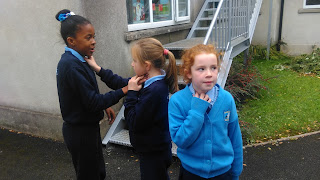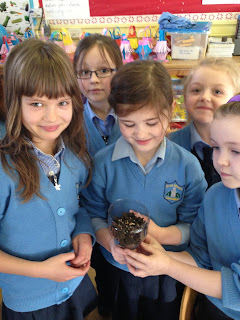In our school we are really good at doing our bit for the enviroment because we have 6 green flags!!!. We know from getting our second green flag that it is important to save as much energy as we can at home and at school. We also know that most of the energy we use comes from burning fossil fuels and that some day these are going to run out and that people on planet Earth need to start using more renewable types of energy solar and hydro and wind. So we decided we would like to do our investigation on solar energy.
First we looked at examples of things we know that already use solar power and we didn't need to look very hard because they were sitting on our desks- our calculators! Teacher also explained to us that some houses use solar panels to help heat the water and the house as well.
We carried out an experiment to see if the sun could really heat water!
Equipment:
Measuring jug
2 similar size containers
Water2 Thermometers
A sunny spot and a shaded spot
Prediction:
The water that is left in the sun will warm up slightly and the water that is in the shade will stay cold.
Method:
Take two plastic containers, place one in a sunny spot like a window sill and one in a place with no sun
We measured 100ml of water in a jug and poured it into each container.
We wanted to make sure it was a fair test so we used water from the same tap and left both containers in their place for the same length of time.
We put the thermometres into both containers and took note of the temperatures. Then we monitored the temperatures of the containers every half an hour.
Here are the results
Carton in Sun
|
Carton in Shade
|
|
Starting temperature
|
19 degrees
|
15 degrees
|
Temp. after ½ hr.
|
20 degrees
|
16 degrees
|
Temp. after 1hr.
|
22 degrees
|
16 degrees
|
Temp. after 1 ½ hr.
|
22 degrees
|
16 degrees
|
What happened?
The water that had been in the sun was warmer than the water that was left in the shade.
If we had left the water in the sun for longer it might have got warmer but the water in the shaded spot would still have been cold.
Conclusions
Our conclusions from our investigations was that solar energy does work.
Working as scientists

Recording our experiment





























































